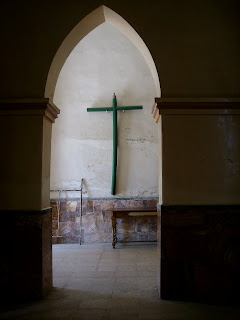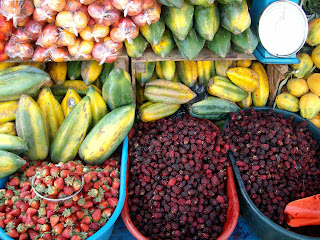Above: Otavalo
Ah, Ecuador – what an astounding country! From the low-lying coasts to the magnificent highlands, this country is diverse in people, heritage, culture (music, arts, language) and food. Ecuador’s 3 biggest exports are oil, bananas and shrimps, and its apparent claim to fame (besides the country’s Galapagos Islands) is its location on the Equator. (I decided to skip the hemispheric line at Mitad del Mundo, 22 KM (13.7 miles) north of Quito, since I hailed from tropical Singapore, a country located near the Equator.)
I traveled from Colombia's hot Caribbean coast to Ecuador's cool Andes in a day’s journey from sunrise to sunset. The journey on Friday took two local taxis, two international flights (on Copa Airlines, with a connection in Panama City) and an interstate bus. By the time I arrived in Ecuador’s northern highland city of Otavalo at 6 PM Friday, I was famished and tired. A minor migraine ensued – I was not sure if this was a result of traveler’s fatigue or the sudden adjustment to the high(er)-altitude (the elevation in Otavalo was 2,550 m or 8,366 ft). Hotel Riviera-Sucre, a charming house with a beautiful courtyard, was a retreat complete with the authentic local atmosphere of rooster crows in the morning. I stayed in a private room with an en-suite bath for US$14/night. Photos of the hotel compound are posted below:
The cost per night at Hotel Riviera-Sucre, by local standards, was pricey relative to everything else in Otavalo. I was glad that inflation had not yet hit this part of the world. The 3-hour bus ride from Quito to Otavalo, for example, was a mere US$2! Meals cost between US$1-2.50 and a bottle of water US$0.30-0.50. In September 2000, Ecuador dumped their Sucre currency for the US dollar, which was a boon for me. To be able to withdraw US dollars from ATMs outside of the US was a first, and relief, for me. :-)
My interactions with the Ecuadorians had been nothing but great. Be they mestizos (people of mixed Spanish and indigenous descent), indigenous, Spanish, or Afro-Ecuadorians, everywhere I went, I was greeted with genuine smiles. Ecuadorians were generally open, friendly, helpful, generous and enchanting.
In Otavalo, the traditionally-dressed otavaleños (indigenous people) were striking to look at with the single pigtails and hat on the men and beautifully embroidered blouses, colorful belts and shawls on the women. They seemed hard-working and remained untouched and unchanged by the increasing hordes of foreign tourists (like me) who visit the town for the oldest (allegedly dating back to 4,000 years!), best-known and most important giant Saturday market in Ecuador and South America. The Saturday market in Otavalo was truly out of this world and I would highly recommend it to all, especially the culture vultures out there. The photos would vouch for me.
Photos of Otavalo:
Photos of the animal market:
Photos of the artisan, food and produce market:
Next post: Quito, Ecuador
Previous post: Cartagena de Indias, Colombia













































































































No comments:
Post a Comment